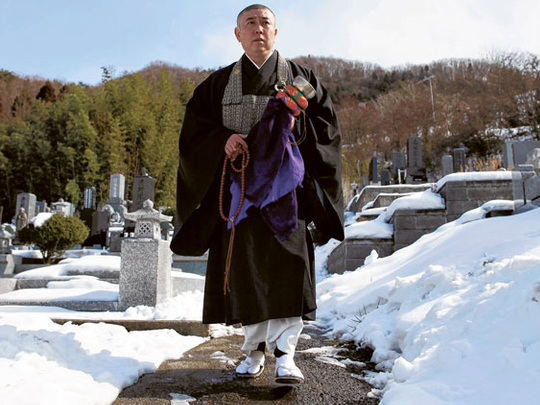
Fukushima: On the snowy fringes of Japan's Fukushima city, now notorious as a byword for nuclear crisis, Zen monk Koyu Abe offers prayers for the souls of thousands left dead or missing after the earthquake and tsunami nearly one year ago.
But away from the cere-monial drums and the incense swirling around the Joenji temple altar, Abe has undertaken another task, no less harrowing — to search out radioactive "hot spots" and clean them up, storing irradiated earth on temple grounds.
The Fukushima Daiichi nuclear plant, some 50km away, suffered a series of explosions and meltdowns after the massive earthquake and tsunami last March 11, setting off the world's worst nuclear crisis since Chernobyl in 1986 and forcing 80,000 people from their homes.
Radiation, carried on winds and by snow, spread far beyond the 20km evacuation zone around the plant, nestling in hot spots across the region and contaminating the ground in what remains a largely agricultural region. Many of those who fled have no idea when, if ever, they can return to land held by their families for generations.
"The damage here in Fukushima is different from the destruction caused by the tsunami," Abe said.
"You can't see it. Nothing looks as if it's changed, but really, radiation is floating through the area. It's hard for those hit by the tsunami, but it's hard to live here too."
Last summer, Abe grew and distributed sunflowers and other plants, such as field mustard and amaranthus, in an effort to lighten the impact of the radiation and cheer up local residents.
Now he is trading his cere-monial robes for a protective mask, working with volunteers to track down lingering pockets of radiation and cleaning them up.
Sense of guilt
One participant is Masa-taka Aoki, a 65-year-old engineer at nuclear plant maker Hitachi for more than 40 years. None of the Fukushima Daiichi reactors was made by Hitachi.
Aoki had long been a believer in nuclear power, but he had a change of faith after the meltdowns and now seeks to assuage a sense of guilt.
"The thing I'd come to believe was good and useful to society turned out to be useless and caused everybody trouble," Aoki said. "I feel a deep sense of remorse."
On a recent weekend volunteers including Aoki looked for radioactive hot spots along a small path which local parents said was mostly used by children on their way to school.
Tests with hand-held Geiger counters yielded results of more than 9 microsieverts per hour, higher than in some areas of the evacuation zone near the plant itself.
Figures from government testing stations within the exclusion zone the same day read between 3.6 microsieverts and 13 microsieverts an hour.










_resources1_16a3106a819_small.jpg)

